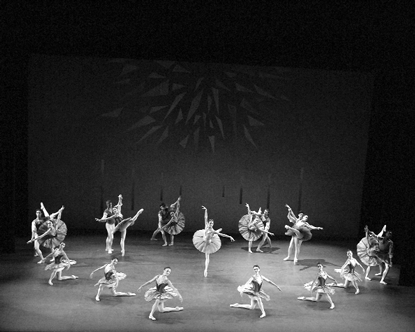Peter Quanz premieres an effervescent “Kaleidoscope” at ABT
American Ballet Theater’s program at City Center Saturday, October 22 could not have been more varied. It began with “Kaleidoscope,” choreographed by the young Peter Quanz to the music of the late-romantic Camille Sant-Saëns—a world premiere. The dance reminds us that ballet, at its best, sweetly elevates the spirit.
Barbara Bilach wonderfully played Sant-Saëns’ “Piano Concerto No. 5.” The composer himself was a brilliant pianist but his compositions are sometimes dismissed as conservative and superficial, but in “Kaleidoscope,” we can appreciate the rigor of Sant-Saëns’ music. The dance embodies the elegance that the composer worked to achieve. In this effervescent ballet, sweetness is not an unhealthy trifle. At the end of the evening, it was the substance of “Kaleidoscope” that had staying power.
Quanz highlights best attributes—Herman Cornejo’s easy affability, Maxim Beloserkovsky’s gallantry as he jetés along a line of female corps. Who is inspecting whom? Veronica Part’s deeply arched torso is the center of emotion in a dark section; the women’s dipped, tipped torsos and turns viscerally ground us. The arms open, suddenly shoot out, and rise, floating. Part falls back almost sitting before the men catch her. The light, spunky Sarah Lane’s baby blue tutu is trimmed with sequins that sparkle with the music in pirouettes. A quartet of men circle with heads down. The magnificent corps of women line up in diagonals or across the stage and sit in scintillating stillness. Though the choreographer aims to showcase ABT’s excellence, the dance transcends this assignment, prevailing as art in its own right and slyly breaking classical conventions.
The lack of symmetry is what makes “Kaleidoscope” interestingly complex. At times the dancers mill about for a few seconds and the unpredictability of their next move provides some of the appeal. The set by Robert Perdziola is a silvery burst of chips, arranged on the cyclorama in a sedate pattern that achieves its elegance also by avoiding exact symmetry.
“Gong” by Mark Morris has its own set of rules, devised by the choreographer on his many forays into faraway dance and music genres. It has moments of fascinating visual spectacle, beginning with a line of colorful dancers bisecting a large circle of white light. Costumes are by Isaac Mizrahi and lighting is by Michael Chybowski. The music is “Tabuh-Tabuhan,” Colin McPhee’s 1936 tribute to the gamelan––a toccata for two pianos and orchestra. Morris injects Balinese-style hands raised in ballet’s first position, above the head. Palms are pressed together and the elbows slightly bent. Pliés too are flavored with flexed feet. Misty Copeland whirls in the brightest magenta tutu with striking chaîné turns; Julie Kent’s feet fly in a brief passage, and Maria Riccetto, David Hallberg, and Craig Salstein outstandingly adapt to Morris’s form for this piece.
The highly anticipated revival of “Rodeo” was the most problematic. Erica Cornejo authentically portrayed the Cowgirl with intentional awkwardness that looked exaggerated and unnatural—and dated. Jennifer Alexander brightened the stage as the Ranch owner’s daughter. Craig Salstein’s tapping was impressive—in boots. This early Americanization of ballet is interesting to see, historically.
What then is authentic? It had the feeling, to the letter, of Agnes DeMille’s choreography. It is hokey, corny, and one year after this effort DeMille choreographed “Oklahoma.” Perhaps the problem is the dance’s false premise stated in the program and attempted by Cornejo. “It’s about the problem that has confronted every American woman from the earliest pioneer times… how to get a suitable man.”
“Rodeo,” with music by Aaron Copeland, came into the ABT repertory in 1950. The highly entertaining classic of musical theater dance was first performed by the Ballet Russe de Monte Carlo in 1942. DeMille chose Christine Sarry in 1969 to dance the Cowgirl for ABT. An excerpt of that revival is available on video. Sarry coached Cornejo for the role in the current revival. Cornejo’s authenticity creates a period piece, a howdy to DeMille, who is celebrating her centennial.
gaycitynews.com



































